
MAY CONTAIN NUTS

Search Shorpy
SHORPY ART

Framed or unframed, desk size to sofa size, printed by us in Arizona and Alabama since 2007. Explore now.
Join and Share
Ad-Free Shorpy
Shorpy is funded by you. Patreon contributors get an ad-free experience.
Learn more.

Recent comments
- Robie House Roof(s)
- There is an interesting novel set here.
- I Was In Berlin
- Pronunciation
- Shell of a Shell
- Never been there but
- BUR-lin
- Hand-made smokes
- Birthplace of Tupperware, or at least its inventor
- Pulp
- Remarkably unchanged in 84 years
- The church is still there ...
- Talk about a smoke show
- Electric Hansom Cab
- I wondered the same thing.
- The location in 2009
- Pill Pusher
- Roll your own
- Rugged and real!
- Civil War history
- Early EV?
- A Charles Purcell - Mama Cass Connection
- Uncle SAAM
- Obfuscation
- One Chocolate Soldier rode away
- Victor Marquis de la Roche
- The Little House Across Way ...
- Vanderbilt Gates
- Vanderbilt Mansion
- You can still see that gate
Member Photos
The Shorpy
Printporium
Printporium
Search Shorpy
Search results -- 30 results per page
- Diamond T: 1920
- ... growing up in the East, my father ran an old sea coast hotel in King's Lynn (Norfolk) for one of the breweries.
When the men ... Posted by Dave - 11/24/2014 - 8:21pm -
![Diamond T: 1920 San Francisco, 1920. "Diamond T truck -- DeLand & Son Draymen." Draymen and drayage being haulage-related terms that eventually became as extinct as the Diamond T. 5x7 glass negative by Christopher Helin. View full size.
Without fixed sidesAnother aspect in the definition of dray is a cart without fixed sides, as illustrated in our current photo.
Drays.Dray and Draymen are still in common usage in England to describe specifically beer deliveries to pubs and bars.
But I've never heard of 'drayage' before.
Not quite dead yet"Drayage" survives! At least in exhibition halls and trade show venues, where the cost of having forty packing crates conveyed from a loading dock to a trade show booth site might just eclipse the value of the display materials themselves. In modern times, the term "drayage" connotes a mashup of operational logistics, fork lifts, and an occupational fervor reminiscent of medieval guilds. It's nice to remember the word, but you'd really better remember to allocate a big pile of cash for drayage.
TeamsterDraymen maybe extinct, but the term teamster is alive even though teams of horses were on there way out in 1920. In horse drawn parlance a dray had the rear wheels no higher than the deck of the body; a wagon with rear wheels that extended above the deck was called a truck.(simplified explanation)
DrayageDrayage as a term is not extinct yet! Here in SC, we have Smith Dray Line http://www.smithdray.com/ . Moving and storing since 1888! Not that anyone would ever suggest SC is mired in the past or anything....
Last MileGranted, the term may be extinct, but draymen and drayage are here to stay. Drayage hauling is one of the most critical components of the global economy's intermodal transportation system. Goods crisscross the globe by rail and ocean freight faster and cheaper per ton than ever before, but still must get from the rail yard or port to customers. This "last mile" of delivery is still done by truck, though Diamond Ts are hard to find.
All of those brown trucks and red-white-blue trucks delivering Amazon, Zappos, and sexynighties.com packages are draymen. The packages arrive by air and make their "last mile" in an panel truck operated by an independent contractor, though the transportation unions would prefer employment. Check out www.drayage.com
My great-great grandfather ran a drayage company by covered wagon from the rail yards to rural customers in Comanche County, TX. He died of pneumonia in his wagon on the banks of the Brazos River in the rain waiting for the flooding river to subside so he could ford it.
More Inventions NeededSomeone needs to invent a forklift. Those crates look very heavy even if they were empty. This truck has solid rubber tires. The cargo and driver have to endure a bone shattering ride.
UK ExtinctionBritish English near equivalents for extinction are 'carrier', 'carter' & 'haulier'.
Drayage Historical Turning PointDrayage got a lot easier when they started using wheels. That didn't affect the term, however.
[A dray is a cart or wagon, so presumably they've always had wheels. - Dave]
I knew a Drayman onceAs a youth in England growing up in the East, my father ran an old sea coast hotel in King's Lynn (Norfolk) for one of the breweries.
When the men delivered the beer barrels and such, my dad referred to them as Draymen. That was back in the early 70's.
Dray definitionAccording to the Oxford English Dictionary a dray was originally a sled and later the term became applied to the low heavy wagons with wheels particularly used by brewers.
The lap of luxuryRoof, tilting "wiggly" glass windshield, padded seat & backrest, leaf springs with maybe a half inch of travel. The life of the drayman.
(The Gallery, Cars, Trucks, Buses, Chris Helin, San Francisco)](https://www.shorpy.com/files/images/SHORPY-142-01.thumbnail.jpg)
- Larry's Beer Garden: 1934
- ... It was featured in Joseph Mitchell's "Up in the Old Hotel." To the left (slightly darker) was Sloppy Louie's. Just to the right was ... Posted by Dave - 09/13/2011 - 1:59pm -
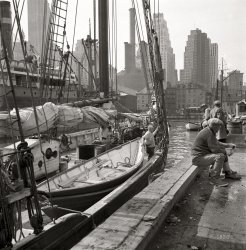
- The Club: 1916
- Circa 1916. "Detroit Athletic Club from the Plaza Hotel." Evidently something of a motorcar magnet. 8x10 glass negative, Detroit ... made their deals in the bar in the Pontchartrain Hotel , where the tables in the "barroom were occupied with men so intent on ... Posted by Dave - 09/14/2014 - 12:25pm -
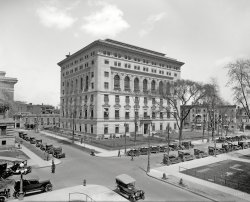
- Allyn House: 1908
- ... Historical Society , the Allyn house was the finest hotel in Hartford when constructed in 1857. It was designed by Octavius J. ... with the rug shop, seems to overlap the front wall of the hotel proper. I wonder if that structure was part of the hotel. Probably not ... Posted by Dave - 09/06/2012 - 5:55am -
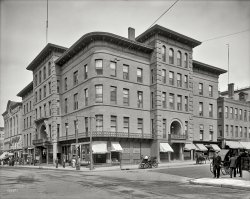
- Gilded Age: 1905
- ... at 57th Street, looking toward Vanderbilt House, Plaza Hotel and entrance to Central Park." 8x10 inch dry plate glass negative, ... Posted by Dave - 03/24/2016 - 3:39pm -
![Gilded Age: 1905 New York circa 1905. "Fifth Avenue at 57th Street, looking toward Vanderbilt House, Plaza Hotel and entrance to Central Park." 8x10 inch dry plate glass negative, Detroit Publishing Company. View full size.
3/4 " G1SThe south entrance of the building at 58th street looks to be temporarily plywooded over. I didn't think it was available then . But it was developed in England in the 1860s and was common by the turn of the century . The 4 x 8 sheets standard today were not produced until 1928 . 1928 was also the year that this building and the 2 past it were replaced by the Bergdorf Goodman building.
Gates.Wonderful photo but what's with all the gates surrounding the buildings? Does anyone know?
[You mean the fences? -tterrace]
Sorry, correct.
+107Below is the same view from April of 2012.
Summer board'emBy the time of the picture, Cornelius Vanderbilt II, had been dead for six years. His widow Alice still lived in the house, but no longer entertained. The boards might be up because she no longer needed the grand entrance for parties.
Also, since it's summertime, she was probably out at her other house, the Breakers in Newport, and had shut this house down for the summer - although boarding up the doors seems excessive.
Tick ... tick ... tickAnd here we are, on the cusp! By the time of this photo, with the center of New York commerce moving inexorably uptown and steel-framed skyscrapers beginning their proliferation, the land on which these magnificent buildings stood was already more valuable for commercial purposes than for residential. The generation that built these mansions usually stuck it out, but when they passed from the scene and multiple beneficiaries inherited, expediency demanded liquidation.
Concomitantly, and especially after World War I relaxed social divisions and occupational constraints, the availability of cheap staff to maintain such homes dwindled. While technological advances partially compensated for that social trend ("Look Cedric, I made toast!"), it nevertheless soon eventuated that only the richest of the rich could afford the huge staffs necessary to clean, maintain, and make comfortable such ostentatious lodgings.
While one certainly rues the loss of such architecture, it's worth considering that the economic and social trends that caused that loss are also the reason that more of us are not now scrubbing pots in some basement scullery.
And the fences (with their gates) are for what fences are always: to exclude those who do not belong (non-members of the Four Hundred) or, in other cases not depicted here, to keep those deprived of their liberty in.
Modern ClothingMaybe my tired old eyes are deceiving me but it looks to me as if the woman standing in the street with the cart is wearing a skirt whose length is more appropriate for a later era.
Maybe she's the 1905 version of a 1920's flapper.
[She and the chap both appear to be youngsters, which would make her skirt length appropriate for the time. -tterrace]
Thanks for the clarification, tterrace.
Re: Modern ClothingGranted, the female in question is a young girl, but we still do see the occasional Shorpy picture from the 1900s where obviously mature women are wearing short(er) skirts.
For instance, the two women on the right, here:
https://www.shorpy.com/node/7880?size=_original#caption
It looks like hem length was more a matter of style and use than modesty; how else to explain the absolute ease with which women of the era wore bathing dress?
Fences/Gates Relocated
http://daytoninmanhattan.blogspot.com/2010/06/vanderbilt-gates.html
(The Gallery, DPC, NYC)](https://www.shorpy.com/files/images/SHORPY-4a18643a.thumbnail.jpg)
- Pennsy Parthenon: 1909
- ... size.
Hold your Horses While I was working in the Hotel Pennsylvania (where that hole is in the foreground) a few years ago, I ... bulk of the construction material for the Station, and the hotel, were brought there by horse and wagon.
Now look at the size of the ... Posted by Dave - 03/31/2017 - 4:54pm -
![Pennsy Parthenon: 1909 Manhattan circa 1909. "New Pennsylvania Station, New York, N.Y." The Beaux-Arts behemoth whose demolition in 1963 lit a fire under the nation's armchair architects. 8x10 inch dry plate glass negative. View full size.
Hold your HorsesWhile I was working in the Hotel Pennsylvania (where that hole is in the foreground) a few years ago, I realized that the bulk of the construction material for the Station, and the hotel, were brought there by horse and wagon.
Now look at the size of the building materials.
Did you know?That it took about nine years to build the station. It was completed about a year after this picture was taken. The building itself covers about 8 acres and is about 1150 ft. tall. When the station was demolished in 1963, only the above ground portion was torn down. The train tracks and lower platforms still exist. This is now the site of Madison Square Garden and the Penn Hotel.
[Over a thousand feet tall? I definitely did not know that. - Dave]
The size of itThe size and scale of the building becomes really apparent when compared to the men working on the roof.
(The Gallery, DPC, NYC, Railroads)](https://www.shorpy.com/files/images/SHORPY-4a23399a.thumbnail.jpg)
- Bull Street: 1901
- ... can see the spires of the (I think) the Oglethorpe House Hotel where Robert E. Lee and other Confederate dignitaries stayed while in ... Posted by Dave - 07/19/2012 - 10:21pm -
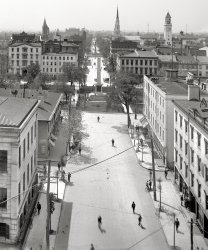
- Hamilton Court Courtyard: 1908
- ... rooms there (suggesting it was built as an apartment hotel rather than a strict apartment house) -- but its it's unusual not to ... Posted by Dave - 09/22/2022 - 1:57pm -
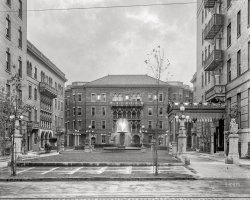
- Battleship: 1940
- ... at which point it went to Seattle to serve as a floating hotel during that city's World's Fair. In late 1962 the Dominion Monarch was ... Posted by Dave - 11/16/2013 - 11:06pm -
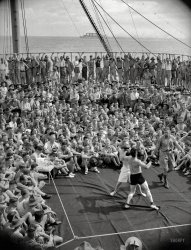
- Cured: 1913
- ... Dr. Friedmann, in fact, retired to his new quarters in the Hotel Ansonia in a very nervous and excited condition. A physician in ... Posted by Dave - 09/11/2011 - 8:11pm -
![Cured: 1913 Washington, 1913. "Dr. Freedman -- Children cured by his cure." Regardless of what the story is here (and I have high hopes that we'll find out), this girl looks like a real piece of work. Harris & Ewing Collection glass negative. View full size.
Friedrich Franz FriedmannA 1913 New York Times article on Dr. F, if this is the same person. Evidently he was regarded as something of a quack.
Dr. Friedrich Franz Friedmann, the Berlin scientist who recently came to New York to demonstrate his so-called "cure" for consumption, gave his first treatment in this country yesterday at the People's Hospital, 203 Second Avenue. The turtle-serum was injected into one woman and two men in the presence of fifty physicians and after the demonstration there was more of criticism than praise for the visiting scientist. Dr. Friedmann, in fact, retired to his new quarters in the Hotel Ansonia in a very nervous and excited condition. A physician in conversation on the street used the term "fakir" in discussing Dr. Friedmann. ...
TB "Miracle Cure"I believe this is probably a "Dr. Friedmann" who was in the New York Times on 16 March 1913, amid discussions of his "miracle cure" for tuberculosis. See the article here.
[These are fascinating. (BTW this is not the same article as the one linked below.) Thanks to all who posted. - Dave]
"Cured" by SerumWashington Post, Sep 9, 1913
"Cured" By Serum
"Blessing From God," declares mother of little girl, who had been given up "by ten doctors" - Has doubled in weight and is every way normal. Other Washington sufferers treated by German said to show improvement
Two of the worst cases treated by Dr. Frederick Friedmann, the noted German physician, on his visit here have been absolutely cured, the sufferers themselves declare, and a number of others have shown such improvement, they assert, as to warrant the patients' hope of ultimate recovery. This statement is the outcome of an investigation into the cases conducted yesterday by a Post reporter. The two patients who it is claimed have been cured are Philip Chase, age 5, of 2114 Fourteenth street southeast, and Edith Strauser, aged 7, of 3221 Reservoir street northwest. ...
The mother of little Edith Strauser yesterday was one of the happiest women in Washington. "Oh to think that my little one has been cured," she cried. "And after ten doctors had given her up. When I took her to the hospital for Dr. Friedmann to operate on her, I did not believe that she had a chance for recovery. The doctors told me that there was no hope. He gave my daughter only one treatment, and within five weeks she showed great improvement. Before I took her to him she had not been able to move in bed for eight months. During those whole eight months she was in agony. Not a muscle could she stir, she was so weak. Today she is able to play with the other children in the neighborhood, although I believe she would still be better if she could get just one more treatment from Dr. Friedmann."
At the time the treatment was given the Strauser child weighed only 23 pounds. Her mother said yesterday that at the end of the five weeks after the operation she had gained fifteen pounds and today weights 45 pounds. Her eyes are a clear as crystal. Her cheeks are ruddy, her complexion fair. She looks like a child that has never been sick in her life. ...
One of the remarkable facts pertaining to the case of the Strauser girl is the disappearance of a large lump that was formed on her back. At the time she was taken to the German physician she was deformed by this protuberance. Today the lump has entirely disappeared.
The mother attributes her daughter's recovery in part, to the manner in which the instruction of Dr. Friedmann was obeyed. "He told me not to give her any medicine after he had given her the serum," she said, "and I have not. I followed his instructions to the letter, and have not let any doctor near her. I have been in communication with a number of his other patients and I find that those who failed to obey his instructions have not fared so well."
Re: Little EdithFascinating. For so many reasons. One of which is that there's not one word in that account about what Herr Doktor is supposed to be curing little Edith of. She's just "sick," was going to have "an operation," but got "serum" instead and was "cured." It's like something out of Dickens!
Although in the Washington Post's defense I will note that an earlier (April 1913) article mentioning Edith describes the treatment as being injections of "turtle serum" for tuberculosis.
A search on his name in the New York Times archive turns up hundreds of citations for 1913 and 1914. He evidently caused quite a stir in this country, going from cause celebre to pariah in a matter of months. The final headline for 1914 reads HEALTH BOARD BANS FRIEDMANN CURE. He died in 1953 in Monte Carlo. Someone should write a book.
Friedmann and HundtOn the LOC site, there are several pictures of the doctor, including one showing him with his secretary, Charles de Vidal Hundt:
Quacked All the Way to the Bank.According to the January-March 1918 issue of The Theosophist, Dr. Friedmann managed to sell his turtle serum cure for a million dollars. Let us shed no tears for the poor doctor.
I've got a secretThis little girl knows something that we do not.
(The Gallery, D.C., Harris + Ewing, Kids, Medicine)](https://www.shorpy.com/files/images/03169a.thumbnail.jpg)
- The Louisburg: 1901
- ... morning and evening. After Miss Balch's death, the hotel was leased, in 1911 to J.A. Sherrad and for two years to L.C. Prior, proprietor of the Lenox Hotel in Boston. In 1916 the Misses Healey of Saratoga Springs ran it. It ... Posted by Dave - 06/12/2015 - 9:48am -
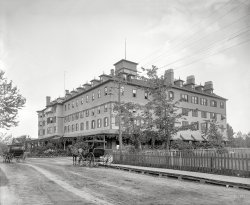
- Cross-Country: 1906
- ... and back." Percy Megargel and David Fassett pass Huber's Hotel on 162nd Street in the Bronx at the end of their 10-month, 11,000-mile ... Posted by Dave - 08/20/2012 - 2:06pm -
![Cross-Country: 1906 New York, June 1906. "REO Mountaineer, New York to San Francisco and back." Percy Megargel and David Fassett pass Huber's Hotel on 162nd Street in the Bronx at the end of their 10-month, 11,000-mile trip in a 16-horsepower touring car. Note the unpaved street at the present-day location of Yankee Stadium. 8x10 inch dry plate glass negative, Detroit Publishing Company. View full size.
Have we got a spare?Back in those days, before steel belted tires, it was not unusual for cars to experience flat tires every few miles. I wonder how many tires they took with them for that 11,000 mile journey, especially driving through Death Valley.
+59It's the opening of The Great Race.
Ready for troubleIt appears they were ready for serious trouble with the rifle in the side holster. Or maybe a little game hunting?
[The gun was for wolves. Details in the comments here. - Dave]
The suspension is killing meMr. Megargel appears to be suffering a bit in the sacroiliac.
Wore out!Back in those days, a car would need major maintinance after 11,000 miles. Rods and main bearings needed adjusting and valves needed lapping. Most likely these vary things were done on the trip. No telling how many tires and how much oil they went through.
re: +59That was hysterical.
More on their tripCan be found in the comments for the previous post on the trip. Including this article. And interestingly enough, Percy Megargel wrote "The Car and the Lady," a fictionalized account of his journey wrapped in a love story.
Blurred photographerThe young man in front of the car is holding a "portable" camera. Looks like a single lens reflex large format camera. Working pretty much like a Hasselblad, but with much better resolution than a medium format camera like the Hasselblad. Very cool to see such a camera in action.
(The Gallery, Cars, Trucks, Buses, DPC, NYC)](https://www.shorpy.com/files/images/4a21368a.thumbnail.jpg)
- Fun in the Sun: 1901
- ... northwest." A mere fraction of Henry Flagler's immense hotel , at one time the largest wood-frame structure in the world. 8x10 glass ... Henry Jackson. View full size.
Amazingly This hotel survived unscathed by fire until its owners razed it as unprofitable, ... Posted by Dave - 01/25/2014 - 11:47am -
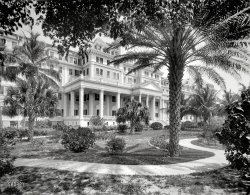
- Ladies Who Lance: 1930
- ... fencing title of the District of Columbia at the Mayflower Hotel this week. Left to right: Elizabeth Bunting, judge; Priscilla Holcombe; ... April 18 and 19 in the Italian garden of the Mayflower Hotel. Entries closed Thursday night and the following were named to compete ... Posted by Dave - 04/26/2013 - 4:36pm -
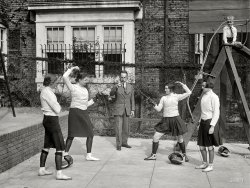
- Ghost Town: 1921
- ... Railway, and Post Office Department, from the Willard Hotel roof." An ethereal, almost spectral view of Pennsylvania Avenue at 14th ... Posted by Dave - 07/22/2012 - 7:12pm -
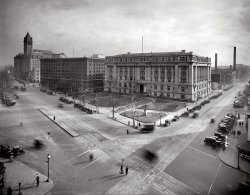
- Win: 1896
- ... the American baseball team, registered at the Occidental Hotel last evening and was found asphyxiated in his room to-day. Mercer was ... gave his residence as Philadelphia. The watchman of the hotel in making his rounds detected the odor of gas coming from Mercer's room, ... Posted by Dave - 02/20/2017 - 8:58pm -
![Win: 1896 Circa 1896. "Mercer, Washington baseball." George Barclay "Win" Mercer (1874-1903). Glass negative from the C.M. Bell portrait studio. View full size.
MERCER'S TRAGIC END
Ball Player, 28, Takes Own Life in San Francisco.
SAN FRANCISCO, Jan. 13 -- Winnie D. Mercer, a pitcher for the American baseball team, registered at the Occidental Hotel last evening and was found asphyxiated in his room to-day. Mercer was registered under the name of George Murray and gave his residence as Philadelphia. The watchman of the hotel in making his rounds detected the odor of gas coming from Mercer's room, and, failing to receive a response to his knocking, broke down the door. Clad in his night clothes and lying in the bed with his coat and vest covering his head, Mercer was found. From the gas jet in the center of the room was suspended a rubber tube, and the end of this Mercer had placed in his mouth, after turning the gas full on.
Mercer's identity was established by papers found among his effects, one of which read: "Tell Mr. Van Horn, of the Langham Hotel, that Winnie Mercer has taken his life." He also left letters, one to his mother and another to a young lady of East Liverpool, Ohio, expressing regret over his deed and bidding them fond farewells. He left a statement of his financial accounts addressed to Tip O'Neill, and advised his friends to avoid games of chance and women.
-- Washington Post, January 14, 1903.
Alternative FactAn odd mistake for the WaPo to have made here, especially for one as well known at the time as Win Mercer was. It should have read "former" pitcher with the Washington Americans, as many called them--because in fact he had been gone from there more than a year, playing for the Detroit Tigers in 1902 and expected to serve as their player-manager in "03. After his sudden demise, Ed Barrow was hired and later saw great fame as Yankees exec in the Ruth/Gehrig era.
[The newspaper article is correct. At the time of his death, Win played for the American League. - Dave]
Cigarettes, whiskey and wild women... threw him a curve he couldn't hit.
Positions: Pitcher, Third Baseman and Outfielder
Bats: Left • Throws: Right
5-9, 154lb (175cm, 69kg)
Born: June 20, 1874 in Chester, WV USA
Died: January 12, 1903 (Aged 28-206d) in San Francisco, CA
Debut: April 21, 1894 (Age 19-305d, 1,762nd in MLB history)
He played 9 years with a record of 132W-164L with an ERA of 3.98 and a BA .285 and OPS .689
In 1901 at the age of 27 he made $3,600.00 which is $105,282.66 in today's dollars. That would be a bargain for a three position player today since the average MLB salary is over $4 million and players still get $100 a day in meal money.
Teams
Washington NL 1894-1899
New York Giants 1900
Washington AL 1901
Detroit Tigers 1902
Career Stats Baseball Reference
Expanded Bio from Society for American Baseball ResearchIt throws a little more light on his sad ending.
(The Gallery, Bell Studio, D.C., Handsome Rakes, Sports)](https://www.shorpy.com/files/images/SHORPY-07121a.thumbnail.jpg)
- More Marquette: 1908
- ... of the most Southern ore dock is located the new Raddison Hotel, this area is known as Founder's Landing.
The open deck in the right ... Posted by Dave - 07/28/2012 - 4:13pm -
![More Marquette: 1908 Resuming our visit to the Great Lakes port of Marquette, Michigan, circa 1908 in a view joining two 8x10 glass negatives. At right is another glimpse of Front Street, showing many of the same buildings seen here yesterday. Moving out of the frame, we continue into the panorama that was the subject of the previous post. Points of interest here include various signs, a baby and a cat. View full size.
Look CloselyCan you spot the broom lying on the rooftop?
"Undertakers Furniture"Not sure what all that would entail, but there must be a market for it somewhere.
Must be payday!Just behind the "Welcome" banner on the right, there's a big lineup of people. Looking at yesterday's "High Noon: 1909" picture, the shop on that corner is the liquor dealer.
I spyAnybody spotted the woman holding the baby yet?
[And a cat! - tterrace]
Roof RoofYes, Phillips, the broom is lying just to the right of a chimney atop the building across the street from B. Neidhardt Sporting Goods and Fishing Tackle, pretty much in the middle of the photograph.
The roofs of buildings in those days are a world of their own, far more interesting than anything today! Chimneys, smoke or steam pipes rising up everywhere, dormer rooms, and everything seems to have been built in such a haphazard fashion. So many rooms or wings appear to have been added to buildings after they were built. I guess some kind of code existed then, but it must have been very lax.
And it's 11:45 and all's well!
Aha !I found two brooms!
Sixty years before my time! I live near Marquette and this has so much familiar in it! A big fire in 1938 took many buildings from Washington and Front street. Even though automobiles were common at this time, none to be seen here! In the distance overlooking the ore dock can be seen the Lower Harbor Light House and it is still there along with the stack of the Water Works building. Where the curved track of the most Southern ore dock is located the new Raddison Hotel, this area is known as Founder's Landing.
The open deck in the right foreground in now a parking lot where my wife and I have a geocache!
(Panoramas, DPC, Railroads)](https://www.shorpy.com/files/images/SHORPY_Marquette_Panorama.thumbnail.jpg)
- Electri City 1906
- ... recognized this scene. The magnificent Douglas House hotel is still there and looks amazingly unchanged, as are many of the other ... Posted by Dave - 08/20/2012 - 11:05am -
![Electri City 1906 Houghton, Michigan, circa 1906. "Shelden Street." Houghton was nothing if not well wired. 8x10 dry plate glass negative, Detroit Publishing Co. View full size.
Butterick patternsThese are still sold today. I looked them up and they are selling their closeout styles for 3 bucks each. They retailed for 50 cents new in the early 60's when I sold them.
A memoryMore going on then than today.
It could almost be todayI immediately recognized it. I wish I still lived there-- I'd shoot you a picture. Of the four buildings in the foreground, three are still there. The one front left is gone. The back right one still has the tiny windowed panels over the main windows.
Bright Lights, Big CityI never realized Houghton was that large of a town at the turn of the century. My great grandparents emigrated from Canada to Houghton in the late 1870s. My grandfather worked as a sawyer in the lumber industry till about 1905, when he moved to the really big city -- Detroit.
Hey, I live there!Here's an updated view from 2008. Since then, they've replaced the streetlights, removed that skywalk, and the street is now brick.
Houghton memoriesI attended Michigan Technological University in Houghton in the '60s and immediately recognized this scene. The magnificent Douglas House hotel is still there and looks amazingly unchanged, as are many of the other downtown building on Shelden Avenue. The wires are gone, though.
Digital City 2010The location of the photographer crouched under the hot black cloth is exactly where "Welcome to Houghton" walkway currently is.
[Or was. The skywalk is gone now (see below). - Dave]
View Larger Map
Organic movement of 104 years agoAw, it WAS something beyond well wired.
The streets were well fertilized.
(The Gallery, DPC, Horses)](https://www.shorpy.com/files/images/4a13092a.thumbnail.jpg)
- The Device: 1938
- ... Spa Treatment She's lying on a towel from the Willard Hotel in Washington, DC.
The towel and fan and neck seal suggest some spa ... Posted by Dave - 04/28/2015 - 9:16am -
![The Device: 1938 Washington, D.C., 1938. "Marie Passapae, C. Coy Honsaker" is all it says here. Are there enough clues to tell us what's going on? 4x5 glass negative. View full size.
Details.The nameplate.
Honsaker Sauna CabinOr cabinet.
Iron LungEarly prototype.
[At first glance. But iron lungs aren't top-loading. - Dave]
Spa TreatmentShe's lying on a towel from the Willard Hotel in Washington, DC.
The towel and fan and neck seal suggest some spa treatment.
Apparatus for and method of inducing pyrexiaLooks like it was patented by Charles C. Honsaker:
http://www.google.com/patents/US2203263
"This invention relates generally to the art of "hydrotherapeutics and more particularly to an apparatus for and method of inducing pyrexia in the treatment of various diseases and disorders of the body."
Hot Fog BoxThat's what the inventor, Mr. Honsaker, called it when he exhibited it at a conference on "fever therapy" in New York in 1937. Water at 130 degrees is sprayed on the patient in such fine droplets "that it feels like the sensation of drifting fog," claimed Mr. Honsaker.
SleekPretty nifty, sleek design, and notice the pinstriping too! Someone took pride in their work!
Hot FlashRaising body temperature was an accepted treatment for syphilis before the discovery of penicillin. Typical article from the Western Journal of Medicine, March 1934:
(Technology, The Gallery, D.C., Harris + Ewing, Medicine)](https://www.shorpy.com/files/images/SHORPY-25247a.thumbnail.jpg)
- National Theatre: 1918
- ... several times but other than the scene in the Plaza Hotel where Kaplan's suit is being delivered to the room or is that what you're ... Posted by Dave - 08/27/2012 - 3:21pm -
![National Theatre: 1918 March 1918. The National Theatre on E Street. At right is Shoomaker's, a favorite Shorpy hangout. Harris & Ewing glass negative. View full size.
Back to the SpongeDave, I've seen North By Northwest several times but other than the scene in the Plaza Hotel where Kaplan's suit is being delivered to the room or is that what you're referring to.
[Not sure I follow the question. Script below. - Dave]
Cary Grant at the Ambassador East, on phone to valet:
"Room 463. How quickly can you get a suit sponged and pressed? Yes, fast. 20 minutes? Fine."
Sponge Again Part 2Ok, but how did you remember such an insignificant piece of dialogue from a 50 year old movie.
[I've seen the movie and remembered the line is the best explanation I can give! - Dave]
Sponge AgainThanks, you answered my question. My new question is: How did you come up with that answer to a question so obscure, that quickly? You never cease to amaze me.
[I Googled the script for "North by Northwest." - Dave]
Out With The OldDid the "old" National Theatre burn down?
[The National had been "new" for more than 20 years, having been rebuilt following a fire in February 1885. The building in this photo was was torn down in 1923 and replaced with the current structure. This section of E Street is now part of Pennsylvania Avenue. - Dave]
WindowsThe one thing that always strikes me is all the open windows in these old large buildings, even in the winter. Today, working in Downtown anywhere, the windows will almost certainly be sealed shut, a consequence of our new ventilation systems. What we have lost is the connectedness to the street. It's like walking into a cocoon.
Dairy Lunch"Dairy Lunch" for a restaurant seems so unpalatable. I am wondering if there is some other reason to the name? Did it signify that it was non-kosher because dairy was served there? Or was it the other way around--meaning that there was no meat(only fish) served there?
["Milk bars" and "dairy lunches" were a phenomenon of the 1910s, 20s and 30s, a byproduct of the temperance movement. A lot of these places were bars and pubs before Prohibition. - Dave]
Baths?The pole on the sidewalk on the left side of the image appears to say "Baths." Would this be correct?
[Yes, if you needed one. - Dave]
SpongeThe tailor shop, to the left of National Dairy Lunch, has a sign in its window "Suits Sponged and Pressed." I've never seen or heard that term before. Was it an early form of dry cleaning or an expeditious way of getting the garment clean.
[So you've never seen "North by Northwest." - Dave]
Shows at the National"The Land of Joy" was a Spanish musical revue that opened on Broadway on Oct. 31, 1917 and closed in January 1918 after 100 performances. "Friendly Enemies" opened in New York on July 22, 1918, and closed in August 1919 after 440 performances--a major hit for 1918. The posters must be announcing an out-of-town tryout.
[A January 1918 item in the New York Times has "Friendly Enemies" set for a February opening in New York. For reasons unknown, it didn't happen. The play opened in Atlantic City before going to Washington. - Dave]
(The Gallery, D.C., Harris + Ewing, Performing Arts)](https://www.shorpy.com/files/images/13909a_0.thumbnail.jpg)
- Six and the City Club: 1906
- ... tell me that 12 Wyandotte Plaza was preceded by the Hotel State, which was there from about 1923 to 1973. I can't readily find ... Posted by Dave - 06/15/2017 - 8:53am -
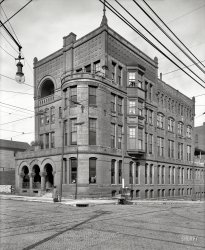
- ADT Messengers: 1908
- ... called the Rhodius Building and contained the Circle Park Hotel.
Look closely at the gap between these two buildings. It and the ... Posted by Dave - 08/13/2013 - 4:02pm -
![ADT Messengers: 1908 A. D. T. Messengers, August 1908. Location: Indianapolis, Indiana. (ADT, or American District Telegraph, was the forerunner of today's home security company.) Photo by Lewis Wickes Hine. View full size.
ADTFinally, now I know what ADT stands for, even the people working there today didn't know what ADT stood for. Thanks to Shorpy, now I know.
Well at least some of us do...I am a current ADT employee
American District Telegraph locationI found a copy of the 1909 Indianapolis City Directory and located ADT's office at 29 Monument Circle (formerly known as 'Monument Place'). This is on the southeast quadrant of the Circle.
See the Google pic below: The location is now occupied by the Indianapolis Power & Light headquarters (1 Monument Circle). The marquee of the Circle Theater next door can be seen, the address of which is 45.
I also included a section from the City Directory for 'Telegraph Companies."
{edit] I came across a wider shot of this same corner, taken in 1905. At the time, the building on the right is where Western Union had their offices. The next building over was called the Rhodius Building and contained the Circle Park Hotel.
Look closely at the gap between these two buildings. It and the building to the right are also in the ADT photo. The white pillar can be seen on both views, as can the ironwork supporting the hanging sign.
No FendersOn those bikes. Trust me: you will get very wet on a street with any amount of water.
(The Gallery, Bicycles, Indianapolis, Kids, Lewis Hine)](https://www.shorpy.com/files/images/03227u.thumbnail.jpg)
- The Wild, Wild East: 1911
- ... Boardwalk Empire Is that Nucky Thompson looking out the hotel window?
(The Gallery, Atlantic City, DPC, Horses, Swimming) ... Posted by Dave - 08/24/2011 - 1:23pm -
![The Wild, Wild East: 1911 Atlantic City, New Jersey, circa 1911. "Savoy Theatre, Schlitz & Young's hotels." 8x10 inch dry plate glass negative, Detroit Publishing Company. View full size.
Re: I'm Freaked OutOh, good. I saw too many '50's sci-fi flicks without my mom's permission
and she always warned me they'd warp my brain.
Best-dressedI must say, the young woman all decked out in classic riding habit at the center is stylin' indeed. Complete with riding crop*, useful should that chap get fresh.
*You can easily make out the handle in her hand, but as she's swinging it slightly, the rest is blurred and blends in with the folds of her skirt.
I'm freaked outWhat the devil IS this?
[Two saddles. - Dave]
For the fairer sex Ladies' side-saddles to be exact.
On the sideNeat! I'm a side saddle rider and I always scan any photo with horses for a glimpse of side saddles or ladies riding aside. Cool to see a side saddle in its original time.
The lady is most likely holding a "hunt whip," which is different from a crop. Hunt whips have an L-shaped handle, usually made of antler, which is handy for hooking onto gates to open them without dismounting. The lash of the hunt whip is used to control the hounds on a hunt.
Weird that the two side saddles that freaked out Rip seem to be "for hire." Riding side saddle is not something you can just hop and and do without some training.
Boardwalk EmpireIs that Nucky Thompson looking out the hotel window?
(The Gallery, Atlantic City, DPC, Horses, Swimming)](https://www.shorpy.com/files/images/4a25632a.thumbnail.jpg)
- Sailing Along: 1903
- ... as far as the eye can see.
A bit of history for the Hotel Ormond here .
(The Gallery, Bicycles, DPC, Florida) ... Posted by Dave - 08/13/2013 - 3:55pm -
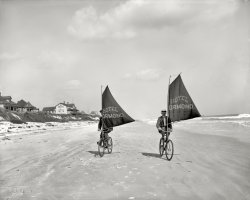
- Foreign Fruits: 1905
- ... we concluded that Light Street ran between the Fountain Hotel and F. Border's Son, both of which face onto Pratt Street, so definitely ... Calvert and Cheapside The street between the Fountain Hotel and Border's is Calvert. A December 23, 1905, F. Border's Son ad in the ... Posted by Dave - 10/12/2017 - 11:25pm -

- Uncle Sam: 1908
- ... gentlemen meet regularly in the bar of a Manhattan hotel to trade stories about their shooting accomplishments and the talents of ... they form a club and name it after their favorite hotel: The Westminster Breeding Association.
(The Gallery, Dogs, G.G. Bain, ... Posted by Dave - 02/10/2013 - 11:06am -
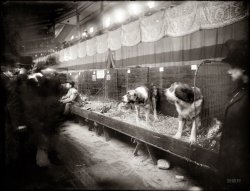
- Mr. O.K.: 1942
- ... well worth visiting. The Wilbur's building is a nice hotel now, fortunately retaining most of the original factory part of the ... Posted by Dave - 04/05/2021 - 10:55am -
![Mr. O.K.: 1942 November 1942. Lititz, Pennsylvania. "Mr. O.K. Bushong, express agent. Two trains a day pass through Lititz on the Lancaster-Reading Railroad. He says that passenger trade has increased 100 percent since war." Photo by Marjory Collins, Office of War Information. View full size.
Looks like the same spot.
O.K. Not O.K.Name: Ohmer King Bushong
Age: 57
Born: 1885
Died: Feb. 20, 1945
Education: 2 years high school
Employment: R.R. Station Agent
Address: 202 S. Broad St. Lititz, Pennsylvania
Wife: Gertrude
O.K. Bushong died at age 60 about 27 months after this photo was taken.
Railroad RhetoricYou want to look and listen, not listen and look, because the light arrives before the sound.
In any case "Stop, look, and listen" is hendiadys - substitution of conjunction for subordination. The original would be "Stop to look and listen."
Stop Listen LookMakes a lot of sense to keep you ears as well as your eyes open for a train. I’ve found listening is very important in some other aspects of driving. There’s a curving hilly road I park and drive on once a week, and whole flocks of cyclists come whizzing down the hill after doing the challenge of going up. When I pull out into traffic from parking at the curb, I can hear the pack coming before I see them coming around the bend, and I always leave my window open and tune my ears to the street for the sound of the speeding bikes.
Over his shoulderHome of the Wilbur Chocolate Company
Nice story about the property here:
https://www.wilburbuds.com/revitalization-wilbur-factory
How times changeI was taught "STOP, LOOK, LISTEN." Progress, I suppose.
Something's not rightShouldn't the sign read " Stop Look Listen"? It's things like this that keep me awake at night.
[When your sign is a circle, the longest word has to be in the middle. - Dave]
OK hairpieceWould you call that a rug? Glad he is proud of his work. I guess railroads were not hurt by the wartime rationing?
What is he leaning on?That thing with the words ROAD PILOT cast into it, what is it?
["The perfect highway signal." - Dave]
Railroad RationingRationing did impact the railroads in many ways and just about anything that could be moved was pressed into service as a result. As big users of steel, many alloys simply weren't available, and the War Production Board limited locomotive production to existing designs for freight or dual-service engines. Railroads were also obliged to locate and provide parts for these new engines from suppliers or make substitutions. Passenger ridership skyrocketed, but production of new cars was prohibited after 1942. Dining cars were subject to the same food restrictions as consumers. Freight cars weren't immune either, with "war emergency" boxcars and hoppers built with wooden sides.
Been Here Many TimesI've been over this RR crossing many times in my life, this being maybe 15 minutes from where I live. Lititz is my dad's hometown, and most of his side of the family lived there. For many years, being there meant the ever-present aroma of Wilbur's Chocolate wafting throughout the town, now just a memory. Same goes for most of the relatives who once lived there. Lititz is a quaint town with many nice little shops, well worth visiting. The Wilbur's building is a nice hotel now, fortunately retaining most of the original factory part of the structure. Many locals, myself included, considered the chocolate once made there, especially "Wilbur Buds," superior to Hershey's.
(The Gallery, Marjory Collins, Railroads, WW2)](https://www.shorpy.com/files/images/SHORPY-8d23496a.thumbnail.jpg)
- The Dining Car: 1902
- ... the traveler the same dining experience as the First Class hotel they left and the one they were traveling too.
Re: Strange Display? ... Posted by Dave - 07/18/2012 - 7:03pm -
![The Dining Car: 1902 Circa 1902. "Delaware, Lackawanna & Western Railroad dining car." 8x10 inch dry plate glass negative, Detroit Publishing Company. View full size.
More on The SilverwareI believe that the waiter would set the appropriate utensils for each course from the attractive arrangement. There isn’t a lot of room at these tables and I have been to restaurants where the waiter set the silver before each course.
Strange Display?The Silver Ware display on the tables looks awfully strange...wonder why that was placed that way?
DL&WThis is what train buffs call "High Varnish." Mighty nice.
I'm pretty sure I haven't missed an opportunity, every time the DL&W is featured here, to mention that when my grandmother rode that line, over 100 years ago, they all said that the letters DL&W stood for Delay, Linger and Wait.
Style of Long Ago....Incredible elegance that was probably taken for granted back then. Superbly designed (notice the condiment racks on the bulkheads), hat racks, nighttime dining with electric lights overhead. And electric fans! What will they think of next. The use of mirrors that visually make the dining car larger than it appears. This dining car appears to have it all! The man in the aisle does have a bit of a ghostly appearance, though.
According to Lucius BeebeThe varnish diners were meant to give the traveler the same dining experience as the First Class hotel they left and the one they were traveling too.
Re: Strange Display?I didn't notice it at first, but you are correct in that the layout is quite unusual. Of course, I absolutely love it, and will try the layout the next time I have a formal dinner party. It almost looks as if it is supposed to represent the railroad crossing sign.
Thanks to a co-worker, the silverware layout has been identified as a "Dragonfly Pattern". - gen81465
Try Your SkillHit the fork handle, flip the knife and spoon into the vase. Win a free order of fries.
Railroad nicknamesRegarding Jazznocracy's comment, it reminded me of a small rail line many years ago that served the timber areas of East Texas. Its official name was the Waco, Beaumont, Trinity and Sabine Railway [WBT & S].
However, due to a constantly precarious financial situation throughout its short life, combined with improper track maintenance as a result, most folks said WBT & S stood for Wobbledy, Bobbledy, Turnover and Stop.
It would be interesting to find out how many other "unofficial" railroad nicknames were out there using the letters of the rail companies.
DL&WAlong with "Delay, Linger and Wait," another DL&W nickname was "Dread, Long and Weary." My dad was a lifelong DL&W/EL employee and I often heard those as a kid.
(The Gallery, DPC, Railroads)](https://www.shorpy.com/files/images/SHORPY_4a20189a.thumbnail.jpg)
- Johns Hopkins: 1903
- ... of W. Monument and Cathedral is gone. Peabody Court Hotel, originally built as luxury apartments in 1928, occupies that space now. ... Posted by Dave - 07/19/2012 - 12:57pm -
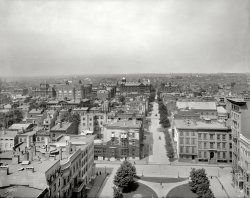
- River City: 1910
- ... "New Orleans, Louisiana. N.O. & Mississippi river from Hotel Grunewald." At left, the Maison Blanche department store on Canal Street. ...
Sorry, could not resist that
Still standing The Hotel Grunewald which became the Roosevelt which became the Fairmont and is now ... Posted by Dave - 03/07/2016 - 12:30pm -
























